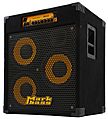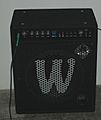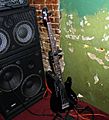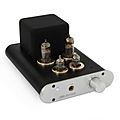Bass instrument amplification is an amplifier used for bass guitars, double bass and similar instruments. It makes the sound they make louder. It is different from other types of amplification systems because it is difficult to reproduce low-frequency sounds (bass). Bass amps need strong loudspeakers, and a relatively larger speaker cabinet. Speaker cabinets for bass instrument amplification usually have larger (or more) loudspeakers than those used for the amplification of other instruments. The loudspeakers themselves must also be sturdier to handle the higher power levels.
Images for kids
-
An Ampeg SVT cabinet with eight 10" speakers, with a separate Ampeg SVT amplifier "head" on top.
-
A Yamaha B100-115 combo amp, which contains a 100 watt amplifier and one 15" speaker in a wooden cabinet.
-
A Hartke 500 watt amp "head" on top of an Ashdown 4x10" speaker cabinet.
-
A 1930s era combo amplifier and a Rickenbacker electric upright bass from 1935.
-
A vintage Ampeg B-15 amp and speaker cabinet.
-
A Kustom 200 bass amplifier from 1971, featuring a separate amp head on top of a 2 x 15" speaker cabinet..
-
A bass rack from a professional bass player's touring setup. The bass amplifier is the lowest chassis in the rack; above it are a wireless receiver, several pre-amplifier devices, and a power conditioner.
-
In this 2007 photo of The Police's singer-bassist Sting, several Ampeg cabinets with multiple 10" speakers can be seen on the left side.
-
Small practice amplifier have low wattage and low volume which make them mostly suited to individual learning of basslines.
-
A Markbass 3x10" combo amp.
-
Bassist Jeff Ament (Pearl Jam) in front of a wall of bass stacks.
-
Psychobilly bassist Jimbo Wallace onstage with Reverend Horton Heat and a large bass stack consisting of a 1x15" cabinet, a 4x10" cabinet, and an amplifier "head".
-
A selection of bass cabinets. From left to right: a Fender cab, a Genz Benz cab (and amp head) and two Aguilar cabinets.
-
A Hartke LH500 bass amplifier "head", which is rated at 500 watts.
-
A Mesa/Boogie bass amplifier "head"; note the graphic equalizer sliders on the right side
-
The glow from four "Electro Harmonix KT88" brand power tubes lights up the inside of a Canadian-made Traynor YBA-200 bass guitar amplifier.
-
A Peavey bass amp head with an Ampeg 8x10" speaker cabinet.
-
A close-up of an Ampeg SVT amplifier head's front panel.
-
A bass stack consisting of an SWR amplifier head on top of Mark Bass 4x10" and 2x10" cabinets.
-
Don Kerr playing a cello through an Acoustic brand amplifier head.
-
The Ampeg Portaflex is a small, lightweight, yet powerful bass amplifier head. It is small and light enough to be carried with one hand, yet powerful enough to run a large bass stack.
-
Music store display showing a variety of bass "combo" amplifiers and speaker cabinets.
-
In some genres, bass players use a large number of speaker cabinets for a powerful onstage sound.
-
A bass reflex enclosure schematic (cross-section).
-
A 150-watt "combo" bass amp with a horn-loaded tweeter (in the top right of the speaker cabinet).
-
The controls for a rackmount bass amp "head", the Hevos400D.
-
An unusual feature on Ashdown bass amps is a VU meter with a needle, which indicates input signal levels (pictured is the Ashdown ABM-300).
-
This rear view of an Eden WT-400 Traveler Plus amp head shows a 1/4" speaker output, a 1/4" signal out (to plug into a second amp, if needed), a "send" and "return" jack for creating an effects loop, a DI output, auxiliary left and right inputs and a tuner out jack.
-
The rear jack plate of an Ashdown 4x10" speaker cabinet shows the parallel speaker cable jacks that are usually provided on speaker cabs.
-
A DNA-1350 amp head; note the three indicator LEDs on the right-hand side, indicating amplifier status.
-
A jazz bassist performing on an upright bass, using an amplifier and speaker to augment the instrument's natural volume
-
A selection of bass effect pedals at a music store.
-
Over the years, various Peavey bass amplifiers have had built-in distortion effects.
-
Lemmy Kilmister, the bassist for Motörhead, obtained a natural fuzz bass tone by overdriving his triple 100 watt Marshall Bass stacks.
-
A bass amp head used with two speaker cabs, with each cabinet containing two loudspeakers and a high frequency horn.
-
A Little Dot Mk III tube headphone amplifier.


































